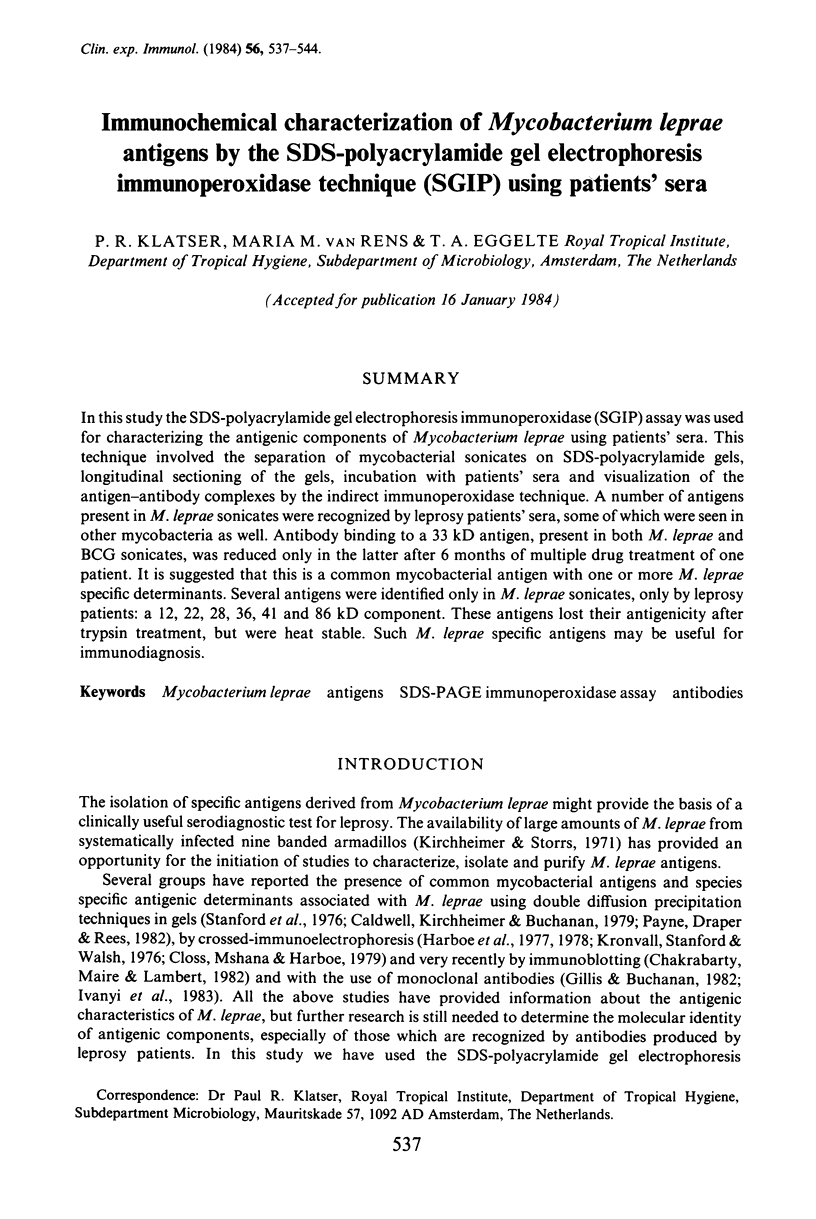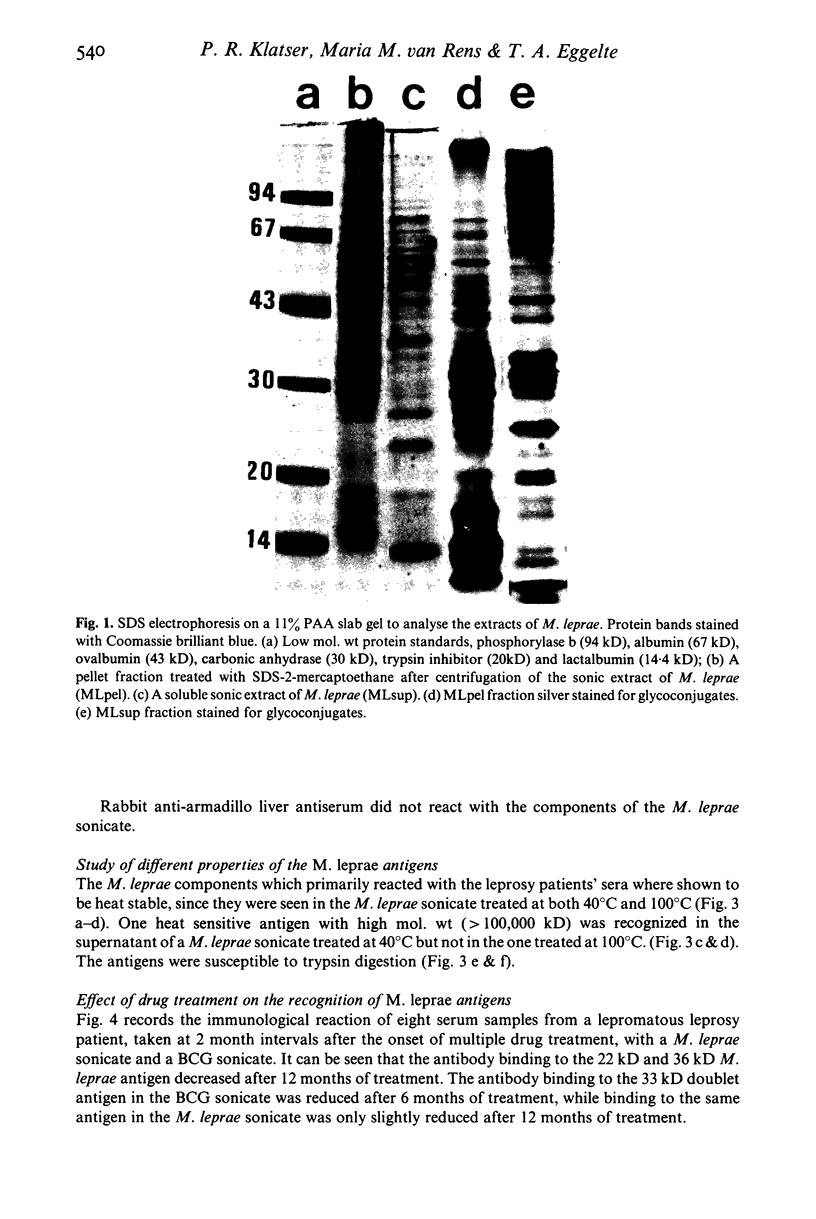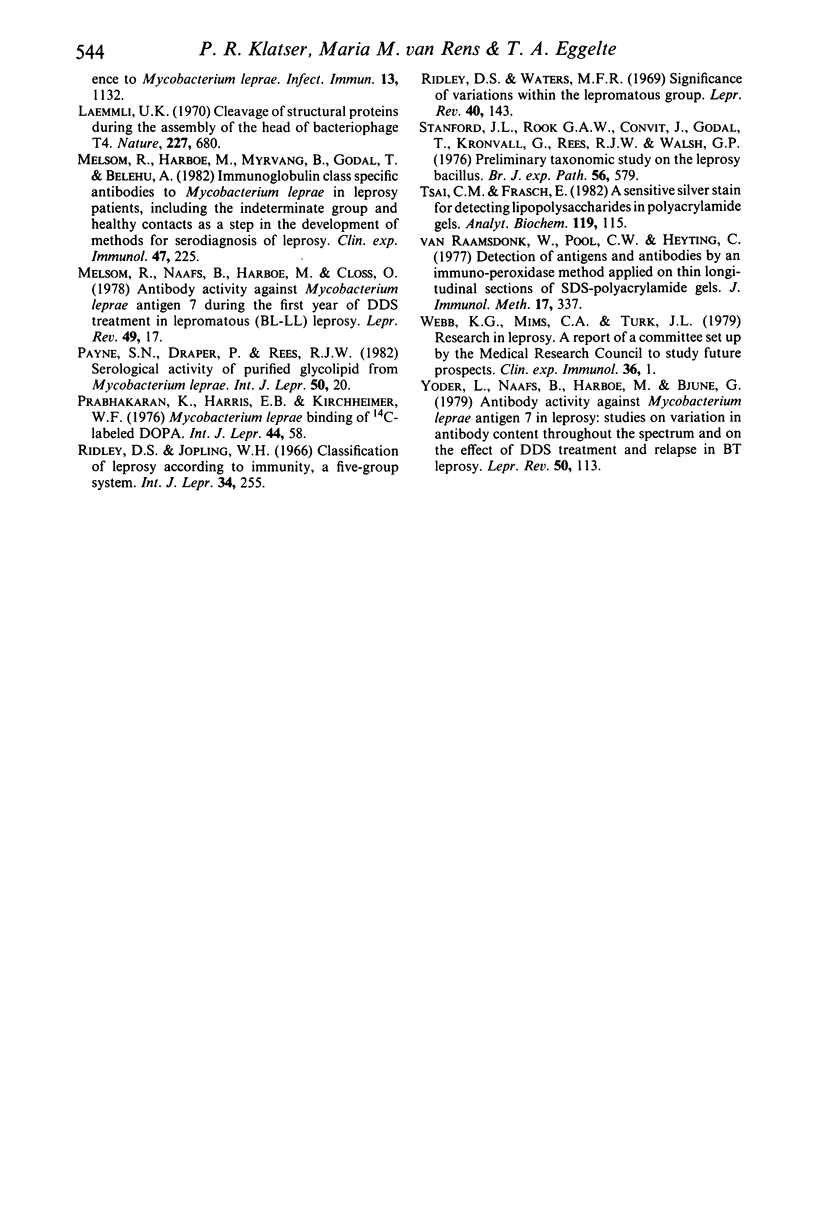Abstract
In this study the SDS-polyacrylamide gel electrophoresis immunoperoxidase (SGIP) assay was used for characterizing the antigenic components of Mycobacterium leprae using patients' sera. This technique involved the separation of mycobacterial sonicates on SDS-polyacrylamide gels, longitudinal sectioning of the gels, incubation with patients' sera and visualization of the antigen-antibody complexes by the indirect immunoperoxidase technique. A number of antigens present in M. leprae sonicates were recognized by leprosy patients' sera, some of which were seen in other mycobacteria as well. Antibody binding to a 33 kD antigen, present in both M. leprae and BCG sonicates, was reduced only in the latter after 6 months of multiple drug treatment of one patient. It is suggested that this is a common mycobacterial antigen with one or more M. leprae specific determinants. Several antigens were identified only in M. leprae sonicates, only by leprosy patients: a 12, 22, 28, 36, 41 and 86 kD component. These antigens lost their antigenicity after trypsin treatment, but were heat stable. Such M. leprae specific antigens may be useful for immunodiagnosis.
Full text
PDF







Images in this article
Selected References
These references are in PubMed. This may not be the complete list of references from this article.
- Brett S. J., Draper P., Payne S. N., Rees R. J. Serological activity of a characteristic phenolic glycolipid from Mycobacterium leprae in sera from patients with leprosy and tuberculosis. Clin Exp Immunol. 1983 May;52(2):271–279. [PMC free article] [PubMed] [Google Scholar]
- Caldwell H. D., Kirchheimer W. F., Buchanan T. M. Identification of a Mycobacterium leprae specific protein antigen(s) and its possible application for the serodiagnosis of leprosy. Int J Lepr Other Mycobact Dis. 1979 Sep;47(3):477–483. [PubMed] [Google Scholar]
- Chakrabarty A. K., Maire M. A., Lambert P. H. SDS-PAGE analysis of M. leprae protein antigens reacting with antibodies from sera from lepromatous patients and infected armadillos. Clin Exp Immunol. 1982 Sep;49(3):523–531. [PMC free article] [PubMed] [Google Scholar]
- Closs O., Mshana R. N., Harboe M. Antigenic analysis of Mycobacterium leprae. Scand J Immunol. 1979 Mar;9(3):297–302. doi: 10.1111/j.1365-3083.1979.tb02735.x. [DOI] [PubMed] [Google Scholar]
- Gillis T. P., Buchanan T. M. Production and partial characterization of monoclonal antibodies to Mycobacterium leprae. Infect Immun. 1982 Jul;37(1):172–178. doi: 10.1128/iai.37.1.172-178.1982. [DOI] [PMC free article] [PubMed] [Google Scholar]
- Harboe M., Closs O., Bjorvatn B., Kronvall G., Axelsen N. H. Antibody response in rabbits to immunization with Mycobacterium leprae. Infect Immun. 1977 Dec;18(3):792–805. doi: 10.1128/iai.18.3.792-805.1977. [DOI] [PMC free article] [PubMed] [Google Scholar]
- Harboe M., Closs O., Rees R. J., Walsh G. P. Formation of antibody against Mycobacterium leprae antigen 7 in armadillos. J Med Microbiol. 1978 Nov;11(4):525–535. doi: 10.1099/00222615-11-4-525. [DOI] [PubMed] [Google Scholar]
- Ivanyi J., Sinha S., Aston R., Cussell D., Keen M., Sengupta U. Definition of species specific and cross-reactive antigenic determinants of Mycobacterium leprae using monoclonal antibodies. Clin Exp Immunol. 1983 Jun;52(3):528–536. [PMC free article] [PubMed] [Google Scholar]
- Kirchheimer W. F., Storrs E. E. Attempts to establish the armadillo (Dasypus novemcinctus Linn.) as a model for the study of leprosy. I. Report of lepromatoid leprosy in an experimentally infected armadillo. Int J Lepr Other Mycobact Dis. 1971 Jul-Sep;39(3):693–702. [PubMed] [Google Scholar]
- Kronvall G., Stanford J. L., Walsh G. P. Studies of mycobacterial antigens, with special reference to Mycobacterium leprae. Infect Immun. 1976 Apr;13(4):1132–1138. doi: 10.1128/iai.13.4.1132-1138.1976. [DOI] [PMC free article] [PubMed] [Google Scholar]
- Laemmli U. K. Cleavage of structural proteins during the assembly of the head of bacteriophage T4. Nature. 1970 Aug 15;227(5259):680–685. doi: 10.1038/227680a0. [DOI] [PubMed] [Google Scholar]
- Melsom R., Harboe M., Myrvang B., Godal T., Belehu A. Immunoglobulin class specific antibodies to M. leprae in leprosy patients, including the indeterminate group and healthy contacts as a step in the development of methods for sero-diagnosis of leprosy. Clin Exp Immunol. 1982 Feb;47(2):225–233. [PMC free article] [PubMed] [Google Scholar]
- Melsom R., Naafs B., Harboe M., Closs O. Antibody activity against Mycobacterium leprae antigen 7 during the first year of DDS treatment in lepromatous (BL-LL) leprosy. Lepr Rev. 1978 Mar;49(1):17–29. [PubMed] [Google Scholar]
- Prabhakaran K., Harris E. B., Kirchheimer W. F. Binding of 14C-labeled dopa by Mycobacterium leprae in vitro. Int J Lepr Other Mycobact Dis. 1976 Jan-Jun;44(1-2):58–64. [PubMed] [Google Scholar]
- Research in leprosy. A report of a committee set up by the medical research council to study future prospects. Clin Exp Immunol. 1979 Apr;36(1):1–7. [PMC free article] [PubMed] [Google Scholar]
- Ridley D. S., Jopling W. H. Classification of leprosy according to immunity. A five-group system. Int J Lepr Other Mycobact Dis. 1966 Jul-Sep;34(3):255–273. [PubMed] [Google Scholar]
- Ridley D. S., Waters M. F. Significance of variations within the lepromatous group. Lepr Rev. 1969 Jul;40(3):143–152. doi: 10.5935/0305-7518.19690026. [DOI] [PubMed] [Google Scholar]
- Stanford J. L., Rook G. A., Convit J., Godal T., Kronvall G., Rees R. J., Walsh G. P. Preliminary taxonomic studies on the leprosy bacillus. Br J Exp Pathol. 1975 Dec;56(6):579–585. [PMC free article] [PubMed] [Google Scholar]
- Tsai C. M., Frasch C. E. A sensitive silver stain for detecting lipopolysaccharides in polyacrylamide gels. Anal Biochem. 1982 Jan 1;119(1):115–119. doi: 10.1016/0003-2697(82)90673-x. [DOI] [PubMed] [Google Scholar]
- Yoder L., Naafs B., Harboe M., Bjune G. Antibody activity against Mycobacterium leprae antigen 7 in leprosy: studies on variation in antibody content throughout the spectrum and on the effect of DDS treatment and relapse in BT leprosy. Lepr Rev. 1979 Jun;50(2):113–121. doi: 10.5935/0305-7518.19790017. [DOI] [PubMed] [Google Scholar]
- van Raamsdonk W., Pool C. W., Heyting C. Detection of antigens and antibodies by an immuno-peroxidase method applied on thin longitudinal sections of SDS-polyacrylamide gels. J Immunol Methods. 1977;17(3-4):337–348. doi: 10.1016/0022-1759(77)90116-8. [DOI] [PubMed] [Google Scholar]






